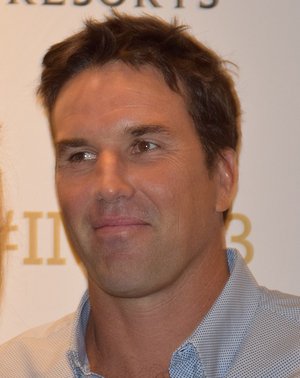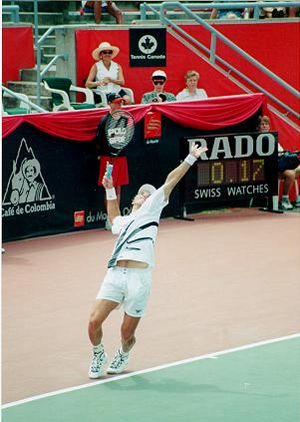Pat Rafter facts for kids

Rafter at the 2015 Australian Open
|
|
| Full name | Patrick Michael Rafter |
|---|---|
| Country (sports) | |
| Residence | Broken Head, New South Wales, Australia |
| Born | 28 December 1972 Mount Isa, Queensland, Australia |
| Height | 185 cm (6 ft 1 in) |
| Turned pro | 1991 |
| Retired | 2003 (last match November 2001) |
| Plays | Right-handed (one-handed backhand) |
| Prize money | US$11,133,128 |
| Int. Tennis HoF | 2006 (member page) |
| Singles | |
| Career record | 358–191 (65.2%) |
| Career titles | 11 |
| Highest ranking | No. 1 (26 July 1999) |
| Grand Slam singles results | |
| Australian Open | SF (2001) |
| French Open | SF (1997) |
| Wimbledon | F (2000, 2001) |
| US Open | W (1997, 1998) |
| Other tournaments | |
| Tour Finals | RR (1997, 2001) |
| Grand Slam Cup | F (1997) |
| Olympic Games | 2R (2000) |
| Doubles | |
| Career record | 214–111 (65.8%) |
| Career titles | 10 |
| Highest ranking | No. 6 (1 February 1999) |
| Grand Slam doubles results | |
| Australian Open | W (1999) |
| French Open | SF (1998) |
| Wimbledon | SF (1996, 1998) |
| US Open | SF (1996) |
Patrick Michael Rafter (born 28 December 1972) is a famous Australian former professional tennis player. He was once ranked as the world's number one player in men's singles. He also reached world number six in doubles.
Patrick Rafter won 11 singles titles during his career. This includes two major championships at the US Open in 1997 and 1998. He also won two important Masters titles. He was a runner-up at Wimbledon twice, in 2000 and 2001. In doubles, Rafter won 10 titles. One of these was a major title at the 1999 Australian Open with his partner Jonas Björkman.
Rafter was the first man in the modern tennis era (called the Open Era) to win three big tournaments in the same year. These were the Canada Masters, Cincinnati Masters, and the US Open. Only Andy Roddick in 2003 and Rafael Nadal in 2013 have done this since. He is also one of only a few men to reach the semifinals of every major tournament in both singles and doubles.
Contents
Patrick Rafter's Tennis Career
Patrick Rafter became a professional tennis player in 1991. He was well-known for his "serve-and-volley" style of play. This means he would serve the ball and then quickly run to the net to hit the next shot.
Early Years in Tennis (1991–1996)
Rafter won his first professional match at Wimbledon in 1993. He made it to the third round before losing to Andre Agassi. He also reached the semifinals in Indianapolis that year. He even beat Pete Sampras in a close match before losing to Boris Becker. Rafter ended 1993 ranked 66th in the world.
In 1994, Rafter won his first singles title in Manchester. This was his only ATP singles title before his big breakthrough in 1997.
Becoming a Star (1997–1999)
Rafter's career really took off in 1997. At the French Open that year, he reached the semifinals. Then, he surprised everyone by winning the US Open. He beat Greg Rusedski in the final. This was his first Grand Slam title. It helped him finish the year ranked number two in the world.
In 1998, Rafter had an amazing year. He won both the Canadian Open and the Cincinnati Masters. He beat Richard Krajicek in the Canadian final and Pete Sampras in the Cincinnati final. Rafter then defended his US Open title, beating fellow Australian Mark Philippoussis in the final. He won six tournaments in 1998 and finished the year ranked fourth in the world.
In 1999, Rafter won the Australian Open men's doubles title with Jonas Björkman. This made him one of the few players to win both a singles and doubles Grand Slam title. At the 1999 French Open, Rafter played against a young Roger Federer in the first round. Rafter won that match. He also reached the Wimbledon semifinals for the first time in 1999.
In July 1999, Patrick Rafter became the world's number one men's singles player. He held this top spot for one week. This makes him the player who held the number one ranking for the shortest time in ATP Tour history. Later that year, he had to stop playing in the US Open due to a shoulder injury that needed surgery.
Later Career (2000–2003)

By July 2000, Rafter's ranking had dropped to 21st. But he still reached the Wimbledon final. In the semifinals, he had an exciting five-set match against Andre Agassi, which he won. In the final, he played against Pete Sampras, who was trying to win his seventh Wimbledon title. Rafter started strong but Sampras won the match in four sets.
Rafter played for the Australian Davis Cup Team in 2000 and 2001, when they lost in the finals. However, he was part of the Australian teams that won the World Team Cup in 1999 and 2001.
In 2001, Rafter reached the semifinals of the Australian Open. He lost a tough five-set match to Andre Agassi. Later that year, he reached the Wimbledon final again. For the third year in a row, he beat Agassi in the semifinals in another long five-set match. In the final, he played Goran Ivanišević. Ivanišević won the close five-set match.
Rafter did not play any professional matches in 2002 because he was recovering from injuries. In January 2003, he announced that he was retiring from professional tennis. He said he no longer had the drive to compete at the highest level.
After Retirement and Comebacks
The main tennis court at the Queensland Tennis Centre in Brisbane, Australia, is named Pat Rafter Arena in his honor. In 2002, he received the Australian of the Year award.
Rafter did return briefly in 2004 to play doubles in two tournaments, but he lost in the first round of both. In 2005, he won the prestigious Jean Borotra Sportsmanship Award.
He was recognized for his great career by being elected to the International Tennis Hall of Fame in 2006. He was also inducted into the Sport Australia Hall of Fame that same year. On Australia Day in 2008, Rafter was added to the Australian Tennis Hall of Fame.
In 2010, Rafter became the captain of Australia's Davis Cup team. He stepped down from this role in 2015.
On 12 January 2014, Rafter, who was 41 years old, announced he would play doubles with Lleyton Hewitt at the 2014 Australian Open. However, they lost in the first round.
ATP Champions Tour
In 2009, Rafter played in the AEGON Masters Tennis, which is a tournament for former tennis champions. He won the final against Stefan Edberg in a very exciting match. This was the first time Rafter had ever beaten Edberg.
Career Statistics
Grand Slam Performance Timeline
| W | F | SF | QF | #R | RR | Q# | A | NH |
| Tournament | 1990 | 1991 | 1992 | 1993 | 1994 | 1995 | 1996 | 1997 | 1998 | 1999 | 2000 | 2001 | SR | W–L |
|---|---|---|---|---|---|---|---|---|---|---|---|---|---|---|
| Australian Open | Q2 | Q1 | 1R | 1R | 3R | 4R | 2R | 1R | 3R | 3R | A | SF | 0 / 9 | 15–9 |
| French Open | A | A | A | Q3 | 4R | 1R | 1R | SF | 2R | 3R | 2R | 1R | 0 / 8 | 12–8 |
| Wimbledon | A | A | Q2 | 3R | 2R | 1R | 4R | 4R | 4R | SF | F | F | 0 / 9 | 29–9 |
| US Open | A | A | Q1 | 1R | 3R | 2R | 1R | W | W | 1R | 1R | 4R | 2 / 9 | 20–7 |
| Win–loss | 0–0 | 0–0 | 0–1 | 2–3 | 8–4 | 4–4 | 4–4 | 15–3 | 13–3 | 9–4 | 7–3 | 14–4 | 2 / 35 | 76–33 |
Grand Slam Finals: 4 (2 Wins, 2 Runner-up)
| Result | Year | Championship | Surface | Opponent | Score |
|---|---|---|---|---|---|
| Win | 1997 | US Open | Hard | 6–3, 6–2, 4–6, 7–5 | |
| Win | 1998 | US Open (2) | Hard | 6–3, 3–6, 6–2, 6–0 | |
| Loss | 2000 | Wimbledon | Grass | 7–6(12–10), 6–7(5–7), 4–6, 2–6 | |
| Loss | 2001 | Wimbledon | Grass | 3–6, 6–3, 3–6, 6–2, 7–9 |
Images for kids
See also
 In Spanish: Patrick Rafter para niños
In Spanish: Patrick Rafter para niños


